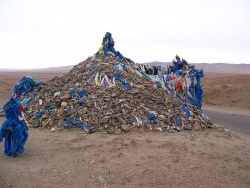Difference between revisions of "Ovoo"
(Created page with "thumb|left|A predominantly wooden ovoo in northern Mongolia thumb|250px|right|Ovoo Image:TallOvoo.JPG|thumb|250px|...") |
|||
| Line 2: | Line 2: | ||
[[Image:Ovoo.JPG|thumb|250px|right|Ovoo]] | [[Image:Ovoo.JPG|thumb|250px|right|Ovoo]] | ||
[[Image:TallOvoo.JPG|thumb|250px|right|Partially wooden and stone Ovoo]] | [[Image:TallOvoo.JPG|thumb|250px|right|Partially wooden and stone Ovoo]] | ||
| − | An ovoo (Mongolian: [[овоо]], heap) is a type of shamanistic cairn found in Mongolia, usually made from rocks or from wood. Ovoos are often found at the top of mountains and in high places, like mountain passes. They serve mainly as religious sites, used in worship of the mountains and the sky as well as in Buddhist ceremonies, but often are also landmarks. | + | An ovoo ({{Wiki|Mongolian}}: [[овоо]], heap) is a type of {{Wiki|shamanistic}} cairn found in [[Mongolia]], usually made from rocks or from [[wood]]. Ovoos are often found at the top of [[mountains]] and in high places, like mountain passes. They serve mainly as [[religious]] sites, used in {{Wiki|worship}} of the [[mountains]] and the sky as well as in [[Buddhist]] {{Wiki|ceremonies}}, but often are also landmarks. |
| − | ==In custom== | + | ==In {{Wiki|custom}}== |
| − | When travelling, it is custom to stop and circle an ovoo three times in clockwise direction, in order to have a safer journey. Usually, rocks are picked up from the ground and added to the pile. Also, one may leave offerings in the form of sweets, money, milk, or vodka. If one is in a hurry while travelling and does not have time to stop at an ovoo, honking of the horn while passing by the ovoo will suffice. | + | When travelling, it is {{Wiki|custom}} to stop and circle an ovoo three times in {{Wiki|clockwise}} [[direction]], in order to have a safer journey. Usually, rocks are picked up from the ground and added to the pile. Also, one may leave [[offerings]] in the [[form]] of sweets, [[money]], milk, or vodka. If one is in a hurry while travelling and does not have [[time]] to stop at an ovoo, honking of the horn while passing by the ovoo will suffice. |
| − | ==In ceremony== | + | ==In {{Wiki|ceremony}}== |
| − | Ovoos are also used in mountain- and [[Wikipedia:Tengrism|sky-worshipping]] ceremonies that typically take place at the end of summer. Worshippers place a tree branch or stick in the ovoo and tie a blue [[khadag]], a [[ceremonial silk scarf]] symbolic of the open sky and the sky spirit Tengger, or Tengri, to the branch. They then light a fire and make food offerings, followed by a ceremonial dance and prayers (worshippers sitting at the northwest side of the ovoo), and a feast with the food left over from the offering. | + | Ovoos are also used in mountain- and [[Wikipedia:Tengrism|sky-worshipping]] {{Wiki|ceremonies}} that typically take place at the end of summer. Worshippers place a [[tree]] branch or stick in the ovoo and tie a blue [[khadag]], a [[ceremonial silk scarf]] [[symbolic]] of the open sky and the sky [[spirit]] Tengger, or {{Wiki|Tengri}}, to the branch. They then {{Wiki|light}} a [[fire]] and make [[food]] [[offerings]], followed by a {{Wiki|ceremonial}} dance and [[prayers]] (worshippers sitting at the [[northwest]] side of the ovoo), and a feast with the [[food]] left over from the [[offering]]. |
| − | ==During communism== | + | ==During {{Wiki|communism}}== |
| − | During Mongolia's Communist period, ovoo worship was officially prohibited along with other forms of religion, but people still worshipped clandestinely. | + | During Mongolia's {{Wiki|Communist}} period, ovoo {{Wiki|worship}} was officially prohibited along with other [[forms]] of [[religion]], but [[people]] still worshipped clandestinely. |
==Influence== | ==Influence== | ||
| − | Ovoos may have influenced or given birth to the Korean {{Wiki|Seonangdang}}. | + | Ovoos may have influenced or given [[birth]] to the [[Korean]] {{Wiki|Seonangdang}}. |
{{W}} | {{W}} | ||
[[Category:Mongolia]] | [[Category:Mongolia]] | ||
Latest revision as of 07:04, 20 July 2014
An ovoo (Mongolian: овоо, heap) is a type of shamanistic cairn found in Mongolia, usually made from rocks or from wood. Ovoos are often found at the top of mountains and in high places, like mountain passes. They serve mainly as religious sites, used in worship of the mountains and the sky as well as in Buddhist ceremonies, but often are also landmarks.
In custom
When travelling, it is custom to stop and circle an ovoo three times in clockwise direction, in order to have a safer journey. Usually, rocks are picked up from the ground and added to the pile. Also, one may leave offerings in the form of sweets, money, milk, or vodka. If one is in a hurry while travelling and does not have time to stop at an ovoo, honking of the horn while passing by the ovoo will suffice.
In ceremony
Ovoos are also used in mountain- and sky-worshipping ceremonies that typically take place at the end of summer. Worshippers place a tree branch or stick in the ovoo and tie a blue khadag, a ceremonial silk scarf symbolic of the open sky and the sky spirit Tengger, or Tengri, to the branch. They then light a fire and make food offerings, followed by a ceremonial dance and prayers (worshippers sitting at the northwest side of the ovoo), and a feast with the food left over from the offering.
During communism
During Mongolia's Communist period, ovoo worship was officially prohibited along with other forms of religion, but people still worshipped clandestinely.
Influence
Ovoos may have influenced or given birth to the Korean Seonangdang.


